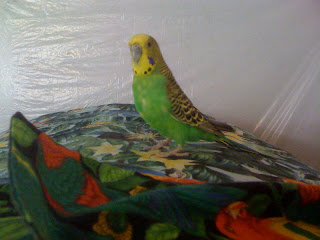Myra is a parakeet or Budgerigar (budgie for short) and has turned seven years old this year. She is not a rescue bird nor did I buy her from a pet store or breeder. She was produced by two of my previous parakeets, Dana and Mason.
Dana was a cinnamon green mutation with a pale yellow face and light brown wings and tail. Mason was a true green wild color budgie with a bright yellow face, dark blue/black wings, and a blue tail. Together they produced three eggs, one of which turned out to be Myra. She was the first to hatch and therefore the largest. The other two were smaller and hatched later. After about two weeks the smallest chick unfortunately passed away. Myra’s younger sibling survived as well and I named him Marty. Both look exactly like their father, Mason. Below you can see a picture of Myra.
Budgies are great starter birds if you’re not familiar with birds. They don’t require a big cage like macaws , they are not loud like the larger parrots and are not high maintenance pets. A safe cage size is 22 inches long, 22 inches wide, and 22 inches tall. The bars of the cage must be close enough together so the bird cannot stick its head through. The cages with horizontal bars are more desirable so the bird can climb more easily.
Your place of residence should be bird proof before bringing in a bird or letting them out of their cage. Even if you don’t let your bird out of its cage, it could fly out while reaching in to change water or feeding. Be sure ceiling fans are off, windows shut and curtains closed, doors to the outside locked, mirrors covered, toilet seats closed, sinks drained, open glasses of liquid covered or emptied, outlets covered, electrical cords are monitored and oven/stove are off or not reachable. The average household contains many hazards to birds. Sometimes in order to protect a bird, one must think on bird terms.
Myra has been such a joy to have around. Her existence was a wonderful surprise to me seven years ago. Dana and Mason were great caring parents. I remember when Dana was sitting on the eggs in the nest box and Mason would be outside, seemingly pacing back and forth like a nervous father-to-be. Every once in a while he would go up to the entrance and peek inside. Dana would then squawk at him as if to say, “Stay out!”
Budgies lay from three to eight eggs in a clutch. After hatching both parents feed the chicks by regurgitating food for them. At around six to eight weeks the chicks begin to eat on their own. Their lifespan can range from 10 to 12 years, but have been known to live longer depending on care. Dana lived to 12 years and passed away earlier this year from unknown causes, whereas Mason passed away at a premature age of 5 years from a brain tumor. Marty--Myra’s brother--sadly passed away late last year.
In the wild these budgies nest in tree cavities. In captivity they will use a nest box supplied by humans. Captive parents will usually tend to the chicks themselves, not needing any help from humans. I only participated by changing the cotton bedding in the nest box twice a day and keeping the food and water dishes refilled.
Budgies are native to the central areas of Australia. They live in desert areas, arid environments and open woodlands. Like all parrots, they are a social species that live in large flocks. If owning just one parakeet, then you become its flock and you must be aware of the extra attention necessary for a budgie to thrive. Just toys will not fulfill the bird’s need for interaction.
Most budgies have their own personalities. Myra is a happy bird that likes to interact with others, but then likes her quiet time alone, too. She is very sweet and is eager to come out of her cage and interact with me. She can be shy and hardly ever picks a fight with any of my other birds. She is a special bird and is a nice reminder of her parents. She is mostly like her dad, Mason, in looks and personality, whereas Marty was most like his mother, Dana—a more dominant personality. Budgies are a wonderful bird to own and I recommend learning as much as you can about the species before deciding to purchase one.







No comments:
Post a Comment